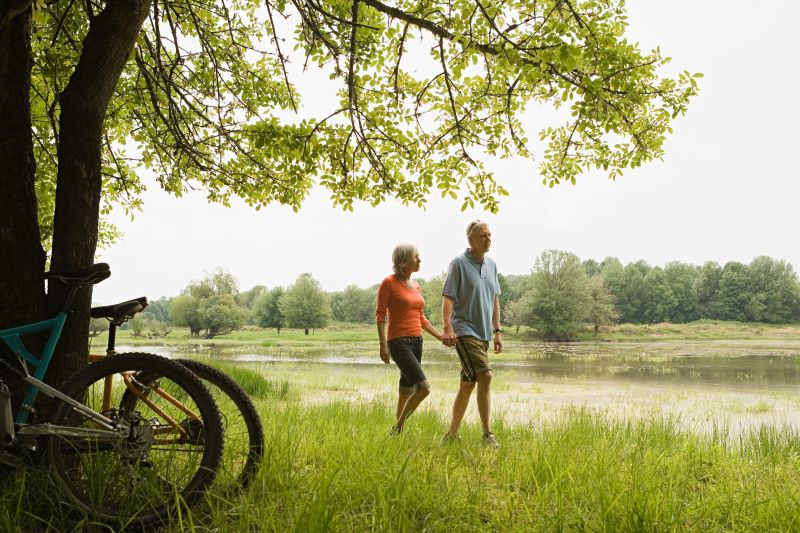The motto, “movement is medicine” summarizes in a short phrase a theme increasingly found in research studies. This theme details that movement, including everything from interval training to low-impact aerobics, can effectively ease the symptoms of some diseases, prevent certain diseases, and possibly even reverse some chronic conditions. Numerous recent studies highlight the role of physical movement in easing or curing the symptoms of various conditions and diseases. In this article, we’ll discuss how certain physical activities can work as an effective medicine for pain, diseases, and chronic conditions you may suffer from.
 Body Movement for Arthritis and Parkinson’s
Body Movement for Arthritis and Parkinson’s
Some of the top headlines from numerous recent studies have a range of implications for the potential of movement to provide effective relief from various conditions and diseases. For instance, physical activities can decrease the symptoms of arthritis by up to 40 percent in some cases. Exercise can also improve some of the symptoms of Parkinson’s while also working to slow its progression. Regular exercise activities, when tailored to some of the needs of Parkinson’s patients may result in less stiffness, improved flexibility of joints and muscles, safer and faster walking ability, less difficulty performing various daily living tasks, better posture, and overall improved quality of life.
Body Movement for Type 2 Diabetes
Exercise can reduce the possibility of gaining type 2 diabetes at some point in your life. You can effectively reduce the possibility of type 2 diabetes by following the public health recommendations to engage in moderate physical activities for at least 150 minutes each week. This exercise regimen can reduce the possibility of type 2 diabetes by up to 26 percent. The essential sentiment of one Science Daily study is that while some exercise can be beneficial toward relieving or reducing the symptoms or presence of some health conditions, more exercise is better. Regular physical exercise can work wonders in reducing diabetes risks.
Body Movement for Heart Disease
Did you know that sitting for too long at a time can also increase your risk of dying early? Studies show that sitting for a prolonged time can reduce the flow of blood to your legs and increase the possibility of heart disease. The possibility of heart disease grows due to the acceleration of plaque build-up in your arteries. Prolonged sitting can also put you at a higher risk for developing depression, diabetes, and obesity. As reported by Harvard Health, with as little as 25 minutes of modest activity a day, you can combat the negative impacts of eight hours of sitting down. Around 60-75 minutes of modest activity a day can eliminate the risk of early death for people who sit for eight hours or more daily.
 Age and Regular Exercise
Age and Regular Exercise
As you grow older, other research indicates that you may experience biological aging at a cellular level with a sedentary lifestyle and a lack of sufficient, regular exercise. The cells of sedentary older women have shorter telomeres. These small caps at the ends of DNA strands work to protect chromosomes from premature aging and deterioration. Low physical activity and an average of 10 hours of sit time can accelerate biological aging. Exercising for a minimum of 30 minutes daily can prevent advanced biological aging. Just be sure to take proper care of your feet with the right shoes for you, regular foot care and maintenance, and possibly orthotics.
Physical Activities for Wellness
Standing and walking around for at least five minutes each hour can also work to effectively improve your well-being and overall health. One study shows that standing and walking around for this amount of time on average during your workday can combat lethargy without decreasing attention and focus, improve your mood, and decrease your hunger pangs. Weight training and aerobic exercise show signs of dramatically improving thinking skills and overall brain health. These physical activities may also slow declines in memory due to or related to age. To prevent foot issues, be sure to warm up, be careful on uncertain terrain, and wear supportive shoes.
Exercise and Brain Health
A range of studies shows a connection between exercise and brain health, including one experiment in which a group of seniors who possessed mild cognitive impairment showed improved thinking skills and memory after around six months of participating in a weight training program. Physical activity appears to also protect against dementia, such as in another study where participants experienced a higher brain volume. There was an increased volume in the hippocampus, the brain’s memory center, effectively decreasing the risk of dementia. Around twenty minutes of daily exercise can also work as an anti-inflammatory for seniors and others.
Exercise and Mental Health
In addition to showing effects in improving brain health and inflammation, exercise has also shown results in improving overall mental health and well-being. Physical activities can work to counter anxiety, stress, and depression, according to the Anxiety and Depression Association of America. Evidence suggests that regular physical activities can improve depression and anxiety as effectively as medication. However, be sure to consult your doctor before stopping any medication regimen. Exercise can also decrease the risk of at least 13 different forms of cancer according to a large-scale study including over one million individuals.
Other Benefits of Activity and Exercise
There are numerous other benefits of activity and exercise proven through documentation spanning years. Physical activities can preserve muscle mass and strengthen bones, lowering the risks of fractures and falls. Exercise can also aid you in maintaining a healthy weight or losing weight, reducing the potential for developing types of diabetes. Physical activity can ameliorate or prevent back pain, and regular exercise can boost your immune system. Boosting your immune system can in turn help you to fight off illness. Research shows that exercise can also raise your self-esteem and satisfaction, improving your overall mood.
 Movement Is Medicine
Movement Is Medicine
When considering how to prevent or relieve health conditions, remember that movement is medicine. For more clarity on prevention and relief, contact the Foot & Ankle Specialists of Illinois.

